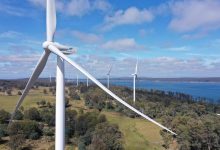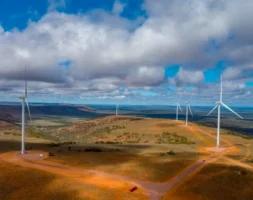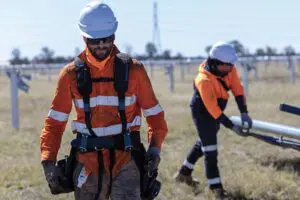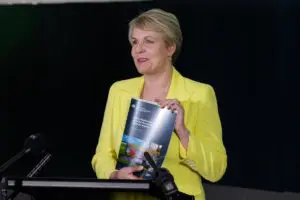Next year will be a big one for climate. In November 2021, Glasgow will host the 26th Conference of Parties conference, COP26, at which the world’s Paris climate agreement members are expected to ramp up their 2030 ambitions significantly, as the US just did. That’s a full year of a post-pandemic drumbeat in which the pressure valve of pent-up anger on climate, put on pause during 2020, is released in massive global waves.
Australia is due to have its next federal election within nine months of COP26, but it could happen any time before that. As we wrap up a year in which Australia’s government essentially trod water while the world made significant (yet insufficient) new strides in the right direction, and Australia sits in the mid-point between elections, it’s worth looking back at one of the most influential moments in the previous federal election in May 2019.
During that election, one of the key media moments involved the federal government commissioning a ‘model’ of the opposition’s climate plan. Like every piece of election modelling, it was dodgy, but it became a headline number that shifted the entire debate away from climate and energy and towards a haze of billions and dollar signs and demands for modelling.
Exploiting a media environment dominated by News Corp, who gladly boosted that modelling, the government created enough doubt and uncertainty to boost its chances in the election, which they eventually won. At the time of release, in February 2019, the ABC’s Media Watch program did a story on it (featuring yours truly, and RenewEconomy editor Giles Parkinson on a related solar beat-up):

At the time, Dylan McConnell from Melbourne University’s Climate & Energy College said that “It’s really quite difficult to critique, given the lack of detail. There are clearly some assumptions that make very little sense to me … and many others seem completely unjustified”.
Well, it turns out that about one month later, the author of that modelling – Brian Fisher from analytics firm BAEceonomics, quietly released the full report, which was “peer reviewed” by a US energy expert, but not published in any academic journal. It is, truly, fascinating reading for understanding exactly the logical hurdles that had to be cleared to reach the conclusion that a 45% emissions cut by 2030 would bring an “apocalypse”.
The modelling assumes the Labor party’s target of 50% renewables by the year 2030, and that under the Liberal-National party, that will be 38%. Here’s the key part – BAEconomics assumes that that extra 12% of renewables comes with very high grid integration costs. While most models of energy systems show lower prices for more renewables, this one comes up with the opposite finding, because “the wholesale price reflects the LCOE of the existing generation capacity, the intermittency and integration costs of wind and solar technologies, and the supply and demand for electricity”. This massive increase in electricity cost filters through the entire model, and likely provides the base of that ‘apocalypse’ headline.
So what’s going on here? The clues are deeper down: “BAEGEM [the model used] assumes that that the intermittency of wind and solar energy does not put cost pressure on the power system until the share of electricity generation from intermittent renewables reaches 20 per cent. Beyond this threshold, the power system requires dispatchable power plants on standby, or sufficient installed battery or other storage to meet any sudden deficit in electricity supply”.
This is the first clue that something is extremely wrong. In the CSIRO’s 2018 GenCost report, a nice graphic created a rough approximation of how the need for grid integration arises only after you exceed around 50% VRE in a grid. That ‘threshold’ for increased cost is shoved back down to 20% in the government’s modelling – a value that isn’t even in the CSIRO’s graphic.
 In fact, the government’s BAEconomics modelling goes into some detail. “BAEGEM assumes that intermittency costs gradually increase from zero to $45/MWh when the share of generation from wind and solar increases from 20 per cent to 35 per cent. The intermittency and integration costs are assumed to peak at $200/MWh when the share of generation from wind and solar exceeds 75 per cent”.
In fact, the government’s BAEconomics modelling goes into some detail. “BAEGEM assumes that intermittency costs gradually increase from zero to $45/MWh when the share of generation from wind and solar increases from 20 per cent to 35 per cent. The intermittency and integration costs are assumed to peak at $200/MWh when the share of generation from wind and solar exceeds 75 per cent”.
That doesn’t sound quite right. The report says “Firming costs are based on estimates in Lovegrove et al. (2018)”. That report was prepared by a group of consultancies, primarily ITP. That report found that “There are multiple affordable options for firm dispatchable renewable electricity generation over all timescales at around one and a half to two times the cost of variable renewable energy (VRE)”, partly prepared by RenewEconomy contributor David Leitch. But it’s tough to find anywhere in that report that puts the integration costs of renewables at $200, and there doesn’t seem to be any modelling of ‘whole of system costs’ by the proportion of renewables in the system.
Regardless of the origin, we can easily compare the integration costs used in the 2019 government modelling to the CSIRO’s 2020 update of the GenCost report, which, for the first time, puts a number on the integration costs of renewables. Again; the CSIRO doesn’t even model the costs below 50%. “We calculated the additional costs of variable renewable generation for VRE shares from 50% to 90%1 for the National Electricity Market. We found that the additional costs to support a combination of solar PV and wind generation in 2030 is estimated at between $0 to $29/MWh depending on the VRE share and region of the NEM”

The CSIRO’s report puts integration costs $5 to $10 per MWh between 70% and 80% VRE. Instead of simply assuming these technologies are paired with relatively expensive energy storage, the model considers a large variety of integration options, such as building transmission lines. These numbers would be even lower if they included demand response.
The government’s 2019 modelling assumed $200 / MWh, for the same ranges of VRE proportion. That’s an over-estimate of between 20 to 40 times.
And the irony of it all? The Coalition now accepts that Australia will reach 50% renewables by 2030 anyway, but it’s not claiming anything like the costs and impact cited by BAE (one of whose founding analysts, incidentally, now sits on ARNA’s board, appointed by energy minister Angus Taylor).
On thing we can be sure of, however, is that those “apocalypse” headlines will be repeated when the next election rolls around.
Update – added comparison chart 18/12/2020











